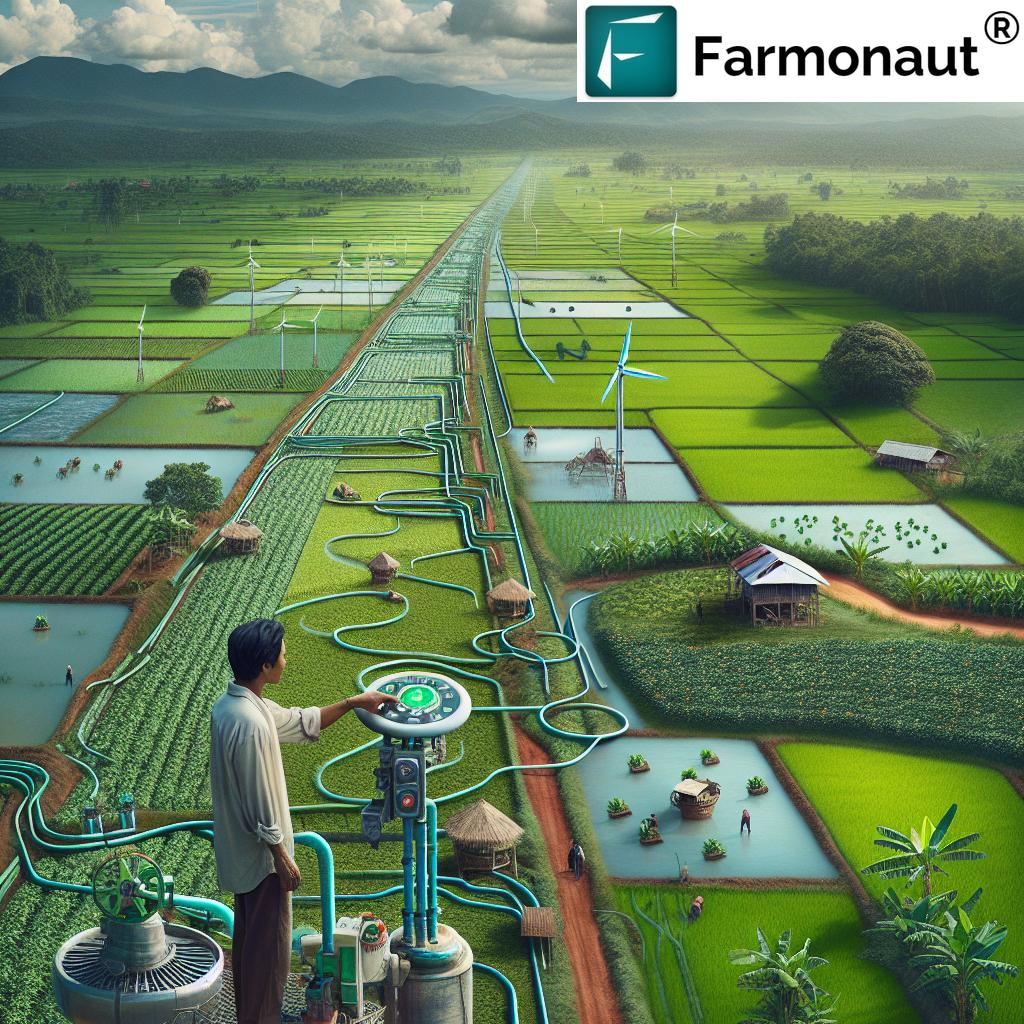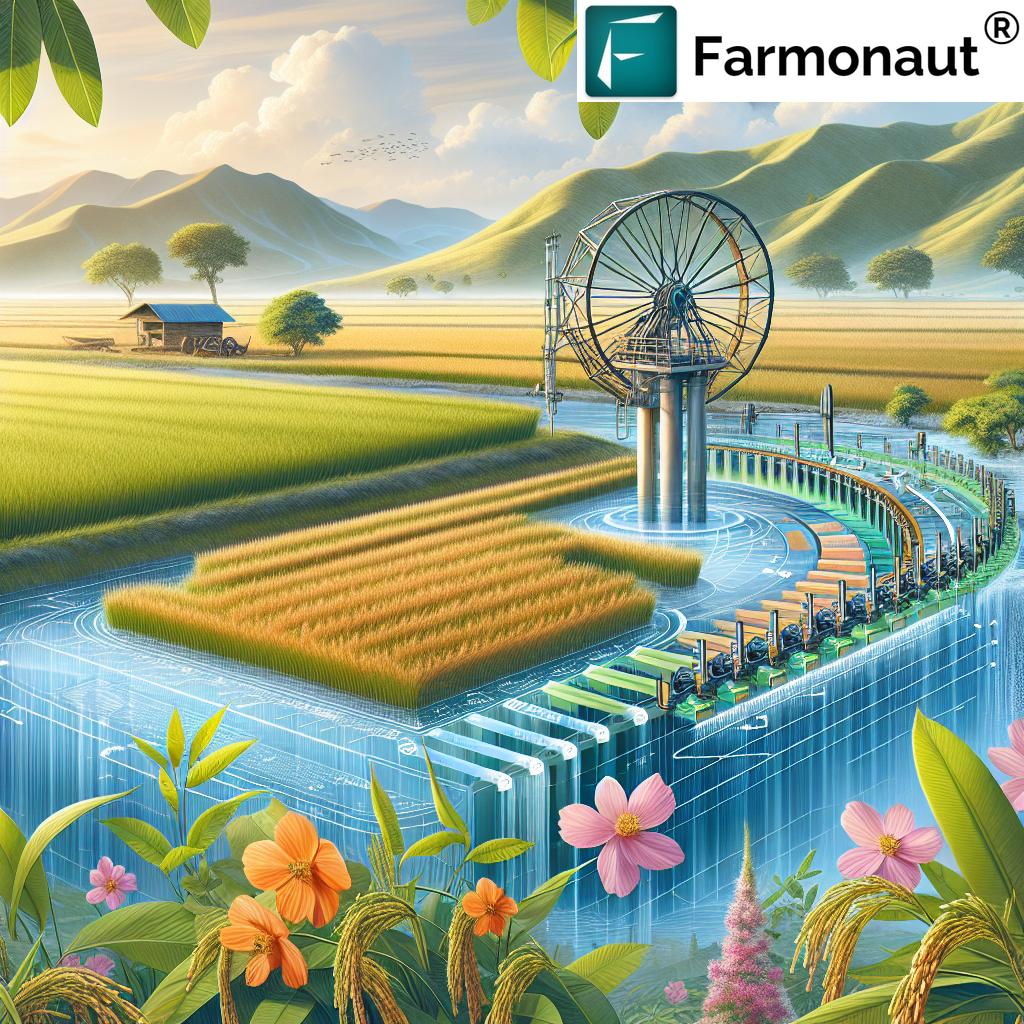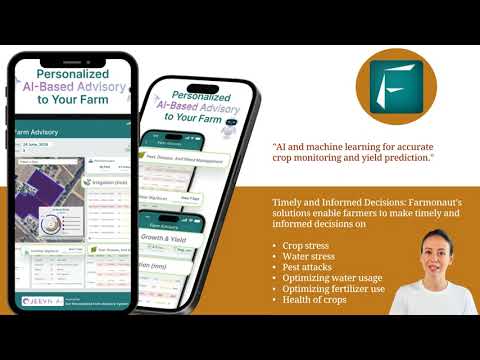Revolutionizing Rice Farming in Cambodia: Sustainable Irrigation Techniques Boost Yields and Rural Development
“Sustainable irrigation techniques in Tahen village, Cambodia, have doubled rice crop yields, enabling two harvests annually.”
In the heart of Cambodia’s lush countryside, a remarkable transformation is taking place. Tahen village, nestled in the Battambang prefecture, has become a beacon of hope for sustainable agriculture in Cambodia. As we delve into this inspiring story, we’ll explore how innovative irrigation techniques for rice farming are not only improving crop yields but also catalyzing a wave of agricultural development in rural areas.
The Challenge: Transforming Traditional Rice Farming
For generations, rice farming in Cambodia has been the lifeblood of rural communities. However, traditional methods often fell short in the face of unpredictable weather patterns and limited resources. In Tahen village, farmers struggled with:
- Inconsistent water supply
- Low crop yields
- Limited farming seasons
- Vulnerability to flooding and drought
These challenges not only affected food security but also hindered economic growth in the region. It was clear that a new approach was needed – one that could harmonize with the environment while boosting productivity.
The Solution: Embracing Sustainable Agriculture
Enter the era of sustainable agriculture in Cambodia. Through a combination of community-driven farming initiatives and expert guidance, Tahen village embarked on a journey to revolutionize its rice production. The cornerstone of this transformation? Advanced irrigation techniques and water management strategies.
1. Check Bank Irrigation System
One of the most significant innovations implemented was the check bank irrigation system. This method involves:
- Creating a series of level basins separated by earthen banks
- Controlling water flow between basins
- Optimizing water distribution across rice fields
The check bank system allows for precise water control, reducing waste and ensuring each part of the field receives adequate irrigation. This technique has proven particularly effective in managing water resources during both wet and dry seasons.
2. Gradient-Based Water Flow Optimization
Complementing the check bank system, farmers in Tahen adopted gradient-based water flow optimization. This approach involves:
- Careful land leveling using laser technology
- Creating a slight gradient across the field
- Allowing for natural, gravity-driven water distribution
By implementing this technique, farmers can ensure even water distribution with minimal energy input, making the irrigation process more sustainable and cost-effective.

The Impact: Doubling Yields and Transforming Lives
The implementation of these sustainable irrigation techniques has had a profound impact on rice farming in Tahen village. The results speak for themselves:
- Doubled crop yields: Farmers now harvest twice the amount of rice compared to traditional methods.
- Two annual rice crops: The improved water management allows for cultivation in both wet and dry seasons.
- Reduced water usage: Despite increased production, overall water consumption has decreased.
- Enhanced soil health: Controlled irrigation has led to better nutrient retention and soil structure.
These improvements have not only boosted food security but have also opened up new economic opportunities for the village.
Beyond Rice: Diversifying Agricultural Enterprises
The success in rice production has inspired Tahen’s farmers to explore diversified agricultural enterprises. We’re seeing a fascinating expansion into:
- Fruit cultivation: Bananas and mangoes are now grown alongside rice.
- Improved animal husbandry: Better practices in raising cattle and other livestock.
- Crop rotation: Introducing vegetables and legumes to improve soil fertility.
This diversification not only provides additional income streams but also contributes to a more balanced and sustainable agricultural ecosystem.
Community-Driven Success: The Heart of Tahen’s Transformation
“Community-driven farming initiatives in Cambodia have improved food security and created employment through local rice milling facilities.”
At the core of Tahen’s agricultural revolution is a strong sense of community. The village has embraced collective action, resulting in:
- Shared knowledge and best practices
- Cooperative management of water resources
- Community-owned milling facilities
- Local employment opportunities in agriculture and processing
These community-driven farming initiatives have not only improved food security but have also fostered a sense of empowerment among the villagers.
The Role of Technology: Enhancing Traditional Farming Methods
While traditional knowledge forms the foundation of Tahen’s farming practices, modern technology plays a crucial role in optimizing production. This is where solutions like Farmonaut come into play.
Farmonaut’s agritech solutions offer small farmers cutting-edge tools to enhance traditional farming methods and optimize production. Through satellite-based crop health monitoring and AI-driven advisory systems, farmers can make data-informed decisions about:
- Irrigation scheduling
- Fertilizer application
- Pest management
- Harvest timing
These technological inputs complement the sustainable irrigation techniques already in place, further boosting efficiency and yield.
Water Management: The Key to Sustainable Rice Production
Effective water management in farming is at the heart of Tahen’s agricultural success. The village has implemented several strategies to optimize water use:
- Rainwater harvesting: Capturing and storing monsoon rains for use during dry periods.
- Drip irrigation: Implementing precise, water-efficient irrigation for fruit trees and vegetables.
- Water-saving rice cultivation: Adopting techniques like alternate wetting and drying (AWD) to reduce water use in paddy fields.
These water management techniques not only conserve this precious resource but also help mitigate the impacts of climate change on agriculture.
Soil Health: The Foundation of Sustainable Farming
Recognizing that healthy soil is crucial for sustainable agriculture, Tahen’s farmers have embraced practices to improve and maintain soil quality:
- Cover cropping: Planting nitrogen-fixing legumes between rice seasons to enrich the soil.
- Reduced tillage: Minimizing soil disturbance to preserve soil structure and organic matter.
- Organic matter incorporation: Returning crop residues to the field to improve soil fertility.
- Balanced fertilization: Using soil testing to apply the right amount and type of fertilizers.
These practices have led to improved soil health, increased water retention, and enhanced nutrient cycling – all crucial factors in sustainable rice production.
The Economic Impact: From Subsistence to Prosperity
The transformation in Tahen’s agricultural practices has had a significant economic impact on the community:
- Increased income: Higher yields and diversified crops have boosted farmer incomes.
- Job creation: New opportunities in farming, processing, and related services.
- Value addition: Local milling and processing facilities allow farmers to capture more value from their produce.
- Reduced reliance on imports: Increased local production has decreased the need for imported rice.
This economic growth has led to improved living standards and greater resilience in the face of economic shocks.
Environmental Sustainability: Balancing Production and Conservation
While increasing production, Tahen village has not lost sight of environmental sustainability. Several initiatives ensure that agricultural development goes hand-in-hand with conservation:
- Integrated pest management: Reducing reliance on chemical pesticides.
- Agroforestry: Integrating trees into farming systems to enhance biodiversity.
- Wetland conservation: Protecting natural wetlands that serve as water reservoirs and wildlife habitats.
- Reduced greenhouse gas emissions: Improved water management in rice fields reduces methane emissions.
These efforts demonstrate that sustainable agriculture can not only feed communities but also protect the environment.

Knowledge Sharing and Capacity Building
The success of Tahen’s agricultural transformation relies heavily on continuous learning and skill development. The village has implemented several initiatives to support this:
- Farmer field schools: Regular training sessions on sustainable farming practices.
- Peer-to-peer learning: Experienced farmers mentoring others in the community.
- Collaboration with agricultural experts: Partnerships with agronomists and researchers to introduce new techniques.
- Use of digital platforms: Leveraging mobile apps and online resources for agricultural information.
These knowledge-sharing initiatives ensure that the benefits of sustainable agriculture are widely disseminated and adopted.
The Role of Technology in Modern Farming
While traditional knowledge forms the backbone of Tahen’s agricultural revolution, modern technology plays a crucial role in optimizing and scaling these practices. Here’s how technology is enhancing farming in the village:
- Satellite-based crop monitoring: Using remote sensing to assess crop health and growth patterns.
- Weather forecasting: Accessing accurate weather predictions to plan farming activities.
- Soil sensors: Monitoring soil moisture and nutrient levels in real-time.
- Mobile apps: Providing farmers with instant access to agricultural information and market prices.
Farmonaut’s platform integrates many of these technologies, offering farmers a comprehensive tool for modern agricultural management. For more information on Farmonaut’s API services, visit Farmonaut API. Developers can access detailed documentation at Farmonaut API Developer Docs.
Comparative Analysis: Traditional vs. Sustainable Rice Farming in Tahen Village
| Farming Aspect | Traditional Method | Sustainable Method | Estimated Impact |
|---|---|---|---|
| Irrigation Technique | Flood irrigation | Check bank system with gradient-based flow | 50% reduction in water usage |
| Annual Rice Crops | 1 crop per year | 2 crops per year | 100% increase in annual production |
| Water Usage (estimated) | High (15,000 m³/ha) | Moderate (8,000 m³/ha) | 47% reduction in water consumption |
| Crop Yield (estimated) | 2-3 tons/ha | 4-5 tons/ha | 66-100% increase in yield |
| Diversification | Monoculture (rice only) | Rice, fruits, vegetables, livestock | 30% increase in overall farm income |
| Community Impact | Limited employment | Increased jobs in farming and processing | 40% increase in local employment |
Challenges and Future Directions
While the success in Tahen village is remarkable, it’s important to acknowledge the challenges and consider future directions:
- Scaling up: Expanding these sustainable practices to other regions in Cambodia.
- Climate change adaptation: Developing strategies to cope with increasingly unpredictable weather patterns.
- Market access: Improving infrastructure and connections to larger markets for increased economic benefits.
- Continued innovation: Exploring new technologies and techniques to further enhance sustainability and productivity.
Addressing these challenges will be crucial for the long-term success and wider adoption of sustainable agriculture in Cambodia.
The Broader Impact: A Model for Rural Development
The transformation in Tahen village serves as a model for agricultural development in rural areas across Cambodia and beyond. Key lessons include:
- The importance of community-driven initiatives
- The power of combining traditional knowledge with modern technology
- The potential for sustainable agriculture to drive economic growth
- The role of diversification in building resilient farming systems
As we look to the future, the success of Tahen village offers hope for a sustainable and prosperous future for rural communities worldwide.
Conclusion: A Sustainable Future for Cambodian Agriculture
The story of Tahen village is more than just an agricultural success – it’s a testament to the power of sustainable practices, community collaboration, and innovative thinking. By embracing sustainable irrigation techniques, diversifying crops, and leveraging modern technology, these farmers have not only improved their yields but have also paved the way for a more resilient and prosperous future.
As we continue to face global challenges in food security and environmental sustainability, the lessons from Tahen serve as an inspiration and a roadmap. They show us that with the right approach, it’s possible to achieve harmony between productive agriculture, community development, and environmental conservation.
The revolution in rice farming in Tahen village is just the beginning. As these sustainable practices spread across Cambodia and beyond, we can look forward to a future where rural communities thrive, food security is strengthened, and agriculture works in harmony with nature.
FAQ: Sustainable Rice Farming in Cambodia
Q: What are the main benefits of sustainable irrigation techniques in rice farming?
A: Sustainable irrigation techniques offer numerous benefits, including reduced water usage, increased crop yields, improved soil health, and the ability to cultivate multiple crops per year. These methods also help in mitigating the impacts of climate change on agriculture.
Q: How has technology contributed to the success of sustainable agriculture in Tahen village?
A: Technology has played a crucial role by providing farmers with tools for precise crop monitoring, weather forecasting, and data-driven decision-making. Platforms like Farmonaut offer satellite-based crop health monitoring and AI-driven advisory systems, enabling farmers to optimize their practices and improve yields.
Q: Can these sustainable farming methods be applied in other regions of Cambodia?
A: Yes, the principles and techniques used in Tahen village can be adapted to other regions in Cambodia. However, it’s important to consider local conditions, such as soil type, climate, and water availability, when implementing these methods in new areas.
Q: How has sustainable agriculture impacted the local economy in Tahen?
A: Sustainable agriculture has significantly boosted the local economy by increasing farm incomes, creating new job opportunities in farming and related sectors, and reducing reliance on imported rice. It has also led to the development of local processing facilities, adding value to the agricultural products.
Q: What role does community involvement play in the success of sustainable farming initiatives?
A: Community involvement is crucial for the success of sustainable farming initiatives. In Tahen, community-driven efforts have led to shared knowledge, cooperative resource management, and the establishment of communal facilities like rice mills. This collective approach has been key to the widespread adoption and success of sustainable practices.






